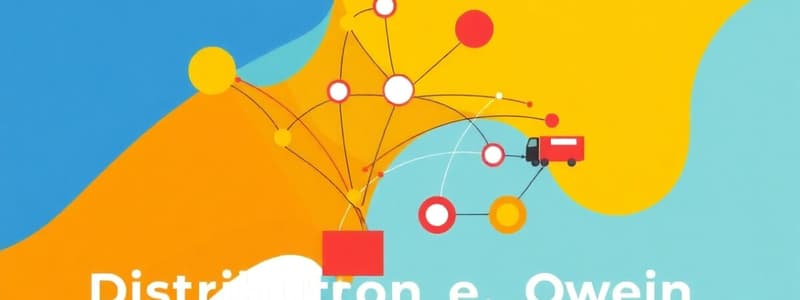Podcast
Questions and Answers
What is the primary role of a distribution network in a supply chain?
What is the primary role of a distribution network in a supply chain?
- To move and store products from suppliers to customers. (correct)
- To manage financial transactions between suppliers and customers.
- To manufacture products efficiently.
- To design new product packaging.
Which two dimensions are used to evaluate the performance of a distribution network?
Which two dimensions are used to evaluate the performance of a distribution network?
- Customer value provided and cost of meeting customer needs. (correct)
- Technological advancements and market share.
- Supplier relationships and inventory turnover.
- Employee satisfaction and environmental impact.
How does the structure of a distribution network affect customer service?
How does the structure of a distribution network affect customer service?
- It primarily changes the marketing strategy.
- It only affects the cost of goods.
- It influences response time, product variety, and availability. (correct)
- It has no impact on customer service.
Which of the following is NOT a supply chain cost influenced by the distribution network structure?
Which of the following is NOT a supply chain cost influenced by the distribution network structure?
What generally happens to the required response time as the number of facilities increases?
What generally happens to the required response time as the number of facilities increases?
How are facility costs related to the number of facilities?
How are facility costs related to the number of facilities?
What is the general relationship between the number of facilities and inventory costs?
What is the general relationship between the number of facilities and inventory costs?
How does transportation cost typically change with an increased number of facilities?
How does transportation cost typically change with an increased number of facilities?
As the number of facilities in a distribution network increases, what generally happens to facility costs?
As the number of facilities in a distribution network increases, what generally happens to facility costs?
Which of the following is NOT one of the key decisions regarding distribution network design?
Which of the following is NOT one of the key decisions regarding distribution network design?
In a 'Manufacturer storage with direct shipping' distribution network, which entity is primarily responsible for delivering the product directly to the end customer?
In a 'Manufacturer storage with direct shipping' distribution network, which entity is primarily responsible for delivering the product directly to the end customer?
Which distribution network design involves combining items from different sources during shipping?
Which distribution network design involves combining items from different sources during shipping?
Which distribution network is best suited for high-volume, low-value products where customers are willing to pick up the items themselves?
Which distribution network is best suited for high-volume, low-value products where customers are willing to pick up the items themselves?
What are the three key flows that occur in the context of omni-channel retailing?
What are the three key flows that occur in the context of omni-channel retailing?
What is a key characteristic of a 'showroom' model in omni-channel retailing?
What is a key characteristic of a 'showroom' model in omni-channel retailing?
Which of the following best describes the relationship between response time and product variety in different distribution channels?
Which of the following best describes the relationship between response time and product variety in different distribution channels?
An online channel typically enjoys which of the following advantages over traditional retail models?
An online channel typically enjoys which of the following advantages over traditional retail models?
When evaluating the selection of a distribution channel, what is an important customer dimension that needs consideration?
When evaluating the selection of a distribution channel, what is an important customer dimension that needs consideration?
Flashcards
Distribution
Distribution
The process of moving and storing products from the supplier to the customer within a supply chain.
Distribution Network's Impact on Profitability
Distribution Network's Impact on Profitability
The choice of distribution network directly impacts the costs and customer value within a supply chain, potentially affecting overall profitability.
Customer Value in Distribution Network Design
Customer Value in Distribution Network Design
The degree to which a distribution network effectively meets customer needs in terms of response time, product variety, availability, and overall experience.
Distribution Network Costs
Distribution Network Costs
Signup and view all the flashcards
Response Time vs Number of Facilities
Response Time vs Number of Facilities
Signup and view all the flashcards
Inventory Costs vs Number of Facilities
Inventory Costs vs Number of Facilities
Signup and view all the flashcards
Transportation Costs vs Number of Facilities
Transportation Costs vs Number of Facilities
Signup and view all the flashcards
Distribution Network Design
Distribution Network Design
Signup and view all the flashcards
Manufacturer Storage with Direct Shipping
Manufacturer Storage with Direct Shipping
Signup and view all the flashcards
In-Transit Merge Network
In-Transit Merge Network
Signup and view all the flashcards
Distributor Storage with Carrier Delivery
Distributor Storage with Carrier Delivery
Signup and view all the flashcards
Distributor Storage with Last Mile Delivery
Distributor Storage with Last Mile Delivery
Signup and view all the flashcards
Manufacturer/Distributor Storage with Customer Pickup
Manufacturer/Distributor Storage with Customer Pickup
Signup and view all the flashcards
Retail Storage with Customer Pickup
Retail Storage with Customer Pickup
Signup and view all the flashcards
Omni-Channel Retailing
Omni-Channel Retailing
Signup and view all the flashcards
Channel Complementarity
Channel Complementarity
Signup and view all the flashcards
Response Time to Customers
Response Time to Customers
Signup and view all the flashcards
Product Variety
Product Variety
Signup and view all the flashcards
Study Notes
Distribution Network Design in Supply Chains
- Distribution moves and stores products from supplier to customer, impacting profitability and customer value.
- Distribution network selection can optimize supply chains for cost or responsiveness.
Factors Affecting Distribution Network Design
- Distribution network performance is measured by customer value and cost.
- Customer service factors (response time, product variety/availability, experience, time-to-market, order visibility, and returnability) are influenced by network structure.
- Supply chain costs (inventories, transportation, facilities, and information) are affected by network structure.
Relationships Between Factors and Number of Facilities
- Figures show relationships between desired response time, inventory costs, transportation costs, facility costs, and the number of facilities.
- A trade-off exists between response time and costs. Increased facilities generally decrease response time and increase costs. Conversely, fewer facilities increase response time and reduce costs.
Distribution Network Design Options
- Key decisions include: delivery method (customer location or pickup) and intermediary use (or intermediate locations).
- Six design options are:
- Manufacturer storage with direct shipping
- Manufacturer storage with direct shipping and in-transit merge
- Distributor storage with carrier delivery
- Distributor storage with last-mile delivery
- Manufacturer/distributor storage with customer pickup
- Retail storage with customer pickup
Omni-Channel Retailing
- Omni-channel retailing uses multiple channels (information, products, and funds) to interact with customers.
- Examples of Omni-channel alternatives include:
- Traditional Retail (face-to-face, high inventory, low transportation costs)
- Showrooms (face-to-face, low inventory, more transportation and information infrastructure)
- Online Information + Home Delivery (high transportation costs)
- Online Information + Pickup (reduced outbound transportation).
Performance Comparison of Channels
- Response time: physical goods are quicker to pick up, while information goods are faster online.
- Product variety: online offers greater variety.
- Product availability: aggregation of inventory increases availability.
- Customer experience: channels offer complementary strengths.
- Time-to-market: online/showrooms are generally faster.
- Order visibility: critical for showrooms and online, automatic in retail.
- Returnability: easier with physical locations.
- Direct Sales: manufacturers can use remote information exchange.
- Funds transfer: internet/smartphones are efficient.
Framework for Omni-Channel Retailing
- Product and customer characteristics (demand uncertainty, value, information complexity, willingness to pay) influence channel selection.
Studying That Suits You
Use AI to generate personalized quizzes and flashcards to suit your learning preferences.




